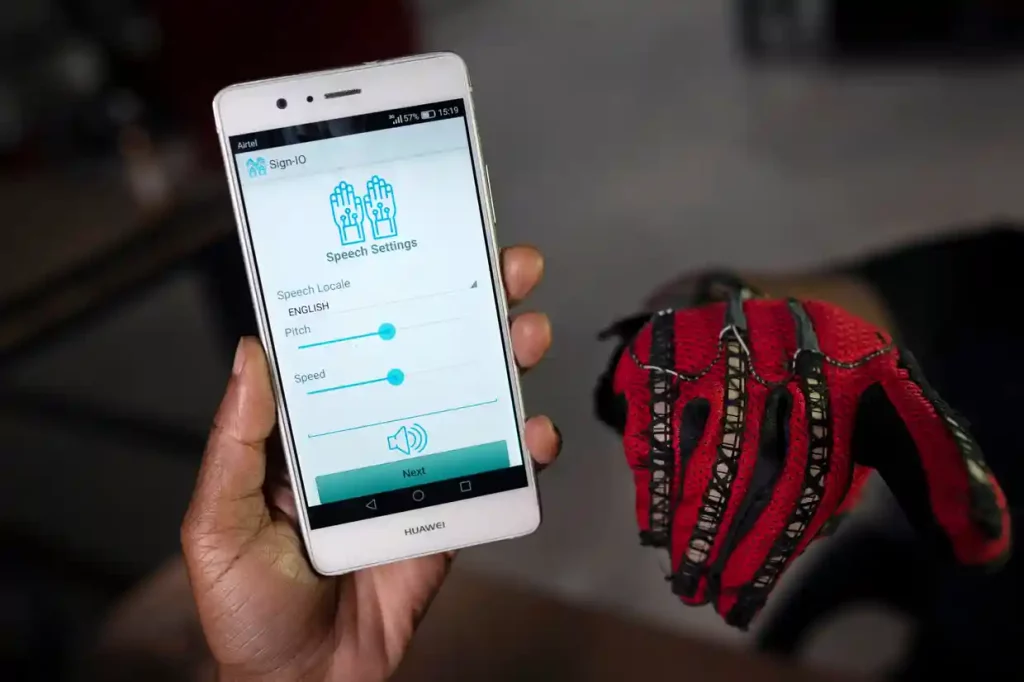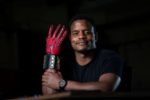Introduction
Kenyan engineer Roy Allela created intelligent gloves that instantaneously transform sign language into audio vocals, which could help over 466 million Deaf people around the globe. Each finger on the gloves has a flex sensor, and a mobile phone app voices the letters after they are Bluetooth-paired. They aim to break down the communication gap between sign language users and the wider public.
Five flexible sensors are sewed onto each finger of the gloves. They measure the amount of finger bending necessary to recognize the letter or sign, then transfer that information over Bluetooth to a smartphone running an Android app. Users can select their preferred gender, language, and even glove color, making it more unique to them.
Additionally, “Sign-IO” received recognition from the American Society of Mechanical Engineers (ASME).
My thoughts
As a former ASL interpreter, I find this invention unique and exciting. It is a considerable benefit for schools and people to know sign language, but I know people are wondering if this will one day replace the interpreter. I believe that the sign-language glove was developed more to address hearing people’s concerns rather than the demands of Deaf signers.
The intelligent gloves invention is also one that multiple people in various countries have created. A glove for data entry utilizing the 26 hand motions of the American Manual Alphabet, which American Sign Language users use, was designed in 1983 by Bell Labs engineer Gary Grimes. Then there was a $10,000 Lemelson-MIT Student Prize awarded to two University of Washington undergrads, Navid Azodi and Thomas Pryor. Then in 2019, Saudi inventor HadeelAyoub, founder of the London-based startup, BrightSign.
He dubbed his invention, which will make it easier for those who are deaf to communicate, “Sign – IO.”
Who is Roy Allela?
Kenyan engineer and inventor Roy Allela, 25, has discovered the ideal means of removing the communication gap between hearing and deaf persons. He created the Sign-IO gloves, which let deaf people “speak” to people who don’t understand sign language by converting hand gestures into audible speech.
What inspired the inventor?
Due to communication difficulties with his 6-year-old deaf niece and his family, Allela was motivated to develop the gloves. “My niece wears the gloves, pairs them to her phone or mine, then starts signing, and I understand what she’s saying. Like all sign language users, she’s very good at lip reading, so she doesn’t need me to sign back,” “In a conversation with The Guardian, he remarked.
The gloves were first introduced at a special needs school in rural Migori county, southwest Kenya, by the young inventor, who is also a data science instructor at Oxford University and works for Intel. To help as many deaf or hard-of-hearing youngsters as possible, he wants it to be accessible in every school for special needs kids.

ABOUT THE GLOVES
In order to track a finger’s movements, including how much it is bent, sensors are attached to each of the five fingers of the Sign-IO gloves. The Android software, which Allela also created, connects the gloves through Bluetooth, converting the movements into voice communication using a text-to-speech feature.
Even though the Sign-IO gloves are still in the prototype stage of development, he has already won prizes and awards for the invention, which have assisted him in making additional advancements. It won the “Hardware Trailblazer Award” in its entirety in 2018 at the American Society of Mechanical Engineers (ASME) global finals in New York, and it placed second at the Royal Academy of Engineering Leaders in Innovation Fellowship in London.
Allela claims that the gloves are 93% successful in translating the signs into speech. The vocalization’s tone and gender can both be changed by users to make it sound more like them. Additionally, they can be embroidered with kid-friendly patterns like a princess or Spider-Man gloves.

Roy Allela’s goal
Allela hopes to assist the 34 million children someday globally who suffer from hearing loss by placing two of his pairs of gloves in each special needs school in Kenya.
Although this fantastic creation may one day aid the billions of individuals with hearing loss worldwide, it all began with a simple desire to improve a relative’s life.
One of the most essential features of the gloves, the speed at which the signals are translated, was one of the problems Allela worked out when testing the gloves at a school in rural Migori County, Kenya.
The American Society of Mechanical Engineers has presented the gloves with the hardware Pathfinder award. He is currently on the shortlist for the 2019 Africa Prize for Engineering.
The Royal Academy of Engineering’s Africa Prize for inventors from six nations has selected 16 young Africans, including Allela, for further consideration. He claims that being recognized is a beautiful affirmation of his efforts and a fantastic chance to promote African inventors.
The American Society of Mechanical Engineers (ASME) global finals in New York awarded it the “Hardware Trailblazer Award” in 2018. The Royal Academy of Engineering Leaders in Innovation Fellowship in London named it a second runner-up.
Sign-IO gloves will be one of many sensor-based products that, if they are made accessible to the general public, are anticipated to generate sales of about $30 billion by the end of 2024.
FUTURE
The IT whiz plans to upgrade the sign language translator program and integrate more precise speech forecasts with the winnings.
Learn more about the company at Sign-IO.com


